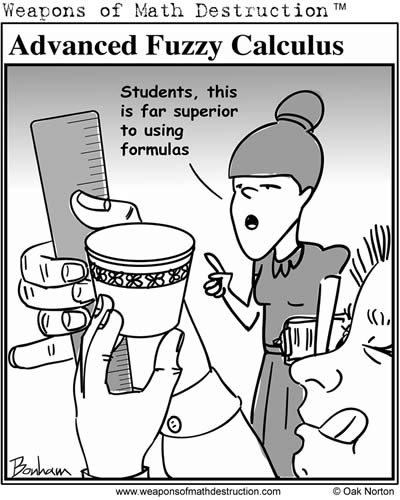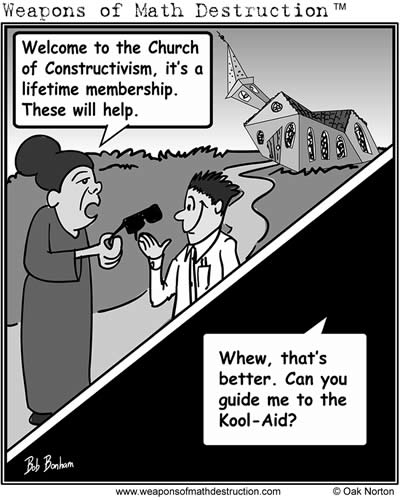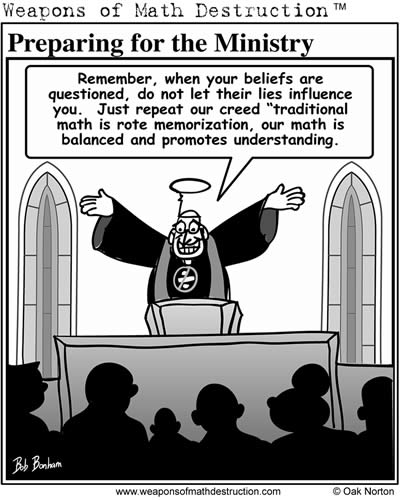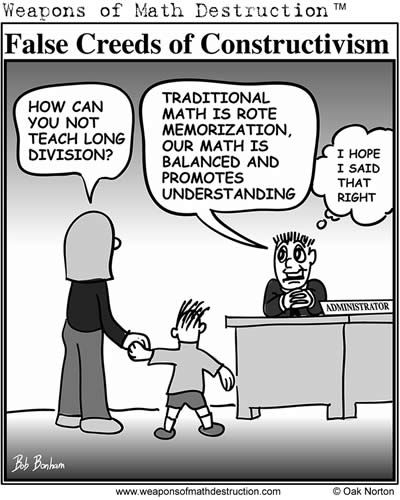BYU's Math Education Department Fails Students
From this article at the Salt Lake Tribune, published July 14th, 2008, I now give you, the rest of the story...
"New Calculus Class Falling Short" by Brian Maffley at the Salt Lake Tribune
Early results from BYU teaching experiment show traditional methods may be better
BYU has for several years been the hotbed of new-age education fads. Constructivism was pushed into Alpine School District thanks to the people at BYU. As parents, we knew the devastating effects it was having on students in our schools and we fought to get rid of Investigations math because of the "brain drain" it was causing.
In the Spring of 2007, BYU's math and science alumni magazine, Frontier, ran a story entitled "Understanding the Path to Understanding Math" and was a glowing brag sheet about how two BYU Math Education professors were teaching this class to give student a deeper understanding of calculus. (click here for a copy).
Two pictures in the article showed individuals cutting apart and measuring Dixie Cups. One caption below one such picture really summed up the class. "For the calculus students, the class offers a dramatically different learning environment." They just forgot to add "for the negative."
Last year I pointed out the article to Mark Cluff, a state school board member. He wrote the professors and asked how the class went.
Dr. Walter & Dr. Gerson,
In case you didn't receive my last e-mail, here it is again.
My name is Mark Cluff. I am a member of the Utah State Board of Education and a BYU graduate in Engineering and Technology.
I read the article on "Understanding the Path to Understanding Math" in the Frontiers magazine. I have a few questions that I hope you can answer.
How did the student performance in the class highlighted in the magazine compare to the student performance within the classes using the traditional instructional model?
If their performance was better, why?
If their performance was worse, why?
Are there any High Schools in Utah using this method of teaching? If so, who are they?
You may answer via email or phone. Thank you for your work and support of Education.
Mark Cluff
District 12
Utah State Board of Education
Thankfully, Drs. Gerson and Walters responded with this (bold text is mine):
Dear Mark,
Thank you for your inquiry regarding our research in calculus project. We were pleased that the Frontiers Magazine was interested in writing an article about our work. International interest has also been expressed regarding our research and classroom practices.
We just completed classroom video data collection, in April, at the end of the semester. Qualitative analysis of three semesters of data has just begun and will be ongoing for several years. We are in the midst of carefully analyzing our data and have not yet conducted full statistical analysis of quantitative data. We are very tightly constrained by federal and university guidelines regarding dissemination of data and findings. However, we would like to respond as best we can to your questions.
The two quantitative measures used to compare our students to those in traditional classes were the common final exam created by the mathematics department and a mathematical belief survey which documents a change in beliefs about mathematics, learning, and teaching. We have a statistical analysis of these quantitative data from the pilot semester of Calculus I.
On the final exam, which was designed as a traditional calculus exam, other sections averages were slightly higher than our section, but not significantly so. We have not yet conducted full statistical analyses of the other two semesters. However, the only semester where our students scored significantly lower on the final exam, there was little or no relation between the exam and the published learning outcomes for the course.
Since our analyses are not yet complete, evidence of changes in student thinking must be considered anecdotal at this point. But it appears that there were significant changes in mathematical beliefs toward originality, creativity and choice, for encouraging self-discovery and independence from memorized rules in teaching mathematics, that mathematics is a creative endeavor, that mathematical problem-solving allows for multiple approaches, and that mathematics is not best taught by direct instruction.
In addition, we are continuing to carry out qualitative analysis of the video data that we gathered in the course as well as look at grades in subsequent related classes, and to collect survey data from the participants. Our ongoing research indicates that conceptual understanding of important calculus concepts was very strong in our sections. And the perception by students of the worth of the class in their respective majors continues to be very high.
With respect to high-school mathematics teaching, there is a continuum of mathematics teaching methods ranging from all drill and practice to all student driven inquiry. Our department’s program is based on a philosophy that supports the training of teachers in building student-centered classroom practices and there are many high school teachers who are teaching with student-centered practices throughout the state.
Incidently, the study Gerald Armstrong and Lee Hendrix did some years ago on a comparison between reformed and traditional calculus, compared student grades in subsequent classes is considered by some to be one of the best analyses of this situation. It is found on the following web site, http://www.mathed.byu.edu/~gma/---under the link; "A Preliminary Study of Traditional and Reformed Calculus."
Sincerely,
Janet G. Walter & Hope Gerson
Assistant Professors
Department of Mathematics Education
Brigham Young University
This email exchange with the above mentioned Frontier's article was passed on to the Tribune and they were asked to investigate these claims. It seems quite unlikely that BYU's calculus exam which is computerized and standardized with the same questions from year to year, would differ from the grade learning expectations published for the students. It turns out that it's not different. The exam and the objectives are in complete harmony.
Telling people the class they taught was correct and the department final which has been the same for years didn't meet the stated objectives of introductory calculus is a pretty bold statement. I think it's the professors who didn't know their class should cover the intended objectives of the course. They should both be banned from teaching math.
Commenting on this article in the Tribune, Dr. Jim Milgram from Stanford shared the following letter with me that he sent to the President of the University and some of the department heads at BYU.
Dear President Samuelson,
It is a sad commentary on the knowledge and competence of people in the education schools that BYU had to try an experimental calculus course run by math educators who seem to believe that method is more important than content in teaching.
Such "experiments" have been tried for nearly 100 years in our colleges and universities. They have virtually always ended in the same way the BYU experiment ended.
For example, about 20 years ago such an experiment was carried out at Stanford. The results were virtually identical to what happened at BYU, but the experiment was better in the sense that the books used were Harvard Calculus and the beta version of what the authors hoped would become "Harvard Advanced Calculus."
Both of these books were written by advocates of discovery learning, and were designed to be taught using discovery methods. Moreover, the lead author was a member of our department at the time.
Only two of our professors used discovery methods in their calculus courses, but all of them used Harvard Calculus as the text. It was hard to see how the students were doing relative to students in previous years as the tests were tailored to the texts. However, the students were having more difficulties in courses in some of their majors.
Things came to a head after about 6 years and the department voted
19 - 1 to change the books to more traditional ones and drop the experiment. But the damage continued.
One year later, I was teaching the differential equations course, and I noticed that most of the students were juniors and seniors majoring in engineering. Usually the students in that course were sophomores.
It turned out that the reason these older students were in the course was that they were having extreme difficulties in their engineering courses. They had an inadequate knowledge of key aspects of calculus that are crucial in engineering. In fact, the topics they needed involved partial fraction decompositions and the corresponding forms for integrals of rational functions, topics that were not present in the Harvard Calculus.
These results should, of course, have been widely reported, but they were not. The only person involved who was in a position to do that was the lead author, and it appeared that he had no interest in studying or publicizing what had happened.
As long as we continue not to learn from past experiences, these tragedies will continue to happen.
Yours,
R. James Milgram
Professor of Mathematics,
Stanford University
Constructivism has once again been proven a complete and total failure, and yet educators accept this fad as doctrine and preach their religion to everyone they meet, as if they held the keys of the kingdom and nobody gets into heaven without their special annointing.
Enjoy these past comics and check out the rest at www.weaponsofmathdestruction.com.
Oak




Investigations Math Menu
** Most important pages to read (all have value but if you will only read
a few pages make it these)
* Very important
|